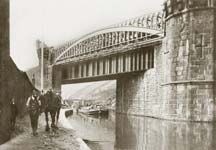|
Home Subscriptions Send us your memories Buy online Links ISSUE 5 CONTENTS Graham Tennant queries the Rattan Clough disaster Help Us Celebrate Our First Birthday The Little School on the Moors |
Over to You Letters to the Editor Eric Webster The floods that occasionally devastate some parts of the Upper Calder Valley remind us that many tributaries provided power for water-driven mills. A century ago a small hydro-electric plant, still in being in 1940, illustrated the possibilities for exploiting even a quite gentle flow. James Murgatroyd and Sons commissioned W.E. Russell to install an h.e. power station using a goit alongside Luddenden Brook, between Booth and Luddenden. Two small turbine houses were built, the remains of which are still identifiable. The turbines charged batteries which supplied current for 2,000 lights in the mill, 120 lights and power for the dairy and lighting of Oats Royd House and Broadfold. It was also proposed to light the church. Best of all, from Murgatroyd's point of view, it required little maintenance and an improvement of 20% on outlays. Since then we've had a century of unbelievable charges. Would it be possible to apply some of these to making use of our streams, without spoiling their natural surroundings? No doubt there would be cries of protest from the electricity and water companies - but so much the better if we, too, could benefit from a 20% reduction! Peter Thornton I feel obliged to inform you that the picture shown on page 17 of issue 4 shows the area known as Copprashouse and not Gauxholme, as stated. This area is nearer to Walsden than Gauxholme and the bridge shown is the next one further up the line.
Photo 013RD: Gauxholme Bridge Mildred Butterworth With reference to the letters about the Pace Egg plays (issue 3): it used to be performed at various parts of Eastwood on Good Friday mornings, just after the war in 1945, by members of Eastwood Sunday School Dramatic Society, who wore their own simple version of the costume but with the original script. Articles about the Coiners interest me as I am one of the dwindling direct descendants of King David, my maiden name being Hartley. I remember my grandfather didn't like people to talk about them as he didn't want anyone to know he had such peculiar relations, even though they were a few generations back! We were looking at David Hartley's grave in Heptonstall a few years ago when a couple of Americans came over to see it. On being told I was a descendant they were thrilled to bits, shaking my hand and saying it had made their day. Jean Higg I was particularly interested in the feature on Hardcastle Crags (issue 4), as my granddad, Midgley Barrett, was landlord of the Pack Horse Inn, Ridge, shown in the old advert. The agreement with Lord Savile was that he rented for a period of 10 years, at £44 5s per annum, which also included 75 acres 3 roods and 38 perches of land, together with all farm buildings. Afterwards, granddad became waterman at Widdop reservoir, for Halifax Corporation Water Works. He retired in 1954 aged 65. Whilst at the reservoir he made friends with all the many local would-be mountaineers. At weekends dozens of young men and women came to climb the rocks across the water from the houses. They brought their own food but grandma made cups of tea for anyone wanting a warm drink. Ken Lobley With reference to the history of Moderna (issue 3): I remember there being a Moderna Club for the young people of the valley, which was on an upper floor in one of the mill buildings. We attended quite a few very enjoyable dances at this club which, I think, opened one evening each week, but maybe other readers can remember it better than I and could offer more information? I met a lot of very nice people at the club and we were all very sorry when it closed. My father was a boiler man at Moderna at this period. Doesn't it do your heart good to see the very attractive young ladies from the Moderna offices, parading the fashions of the period? None of the jeans and sloppy dress of today. Those young ladies certainly knew how to dress and look really attractive. Does anyone remember the names of the models? Joyce Higgins (nee Greenwood) Having begun my working life as a clerk in the office of Moderna I have been particularly interested in the article relating to that firm (issue 3). I wonder if you have had any communications from other members of staff, there from 1934 - '37? If so I would be interested in contacting them. Ed: In answer to both Ken and Joyce: the children featured have been identified (issue 4|) but the young ladies remain a mystery. Editor's note: Apologies to Denis Kaberry, who was inadvertently referred to as Kenneth Kaberry in the last issue of the magazine. A selection of readers' letters from our ever-increasing Post Bag. Keep those letters coming - either by post or on the web! And don't forget - we still want your special memories of Alice for our tribute to her, "Alice's Album," to be published next year. From Milltown Memories, issue 5. If this or other stories stirs a memory, we'd be happy to know - send us your memories and comments. |

